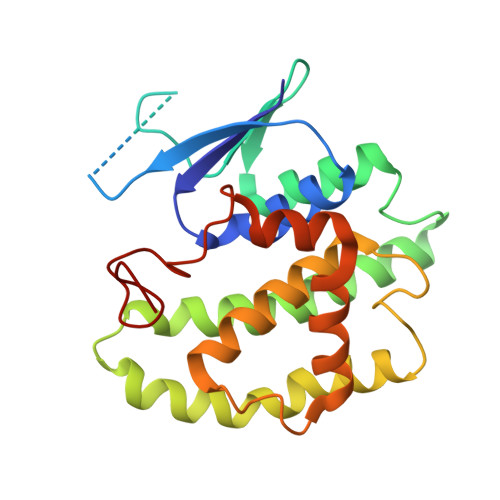Chimeric glutathione S-transferases containing inserts of kininogen peptides: potential novel protein therapeutics.
Bentley, A.A., Merkulov, S.M., Peng, Y., Rozmarynowycz, R., Qi, X., Pusztai-Carey, M., Merrick, W.C., Yee, V.C., McCrae, K.R., Komar, A.A.(2012) J Biol Chem 287: 22142-22150
- PubMed: 22577144
- DOI: https://doi.org/10.1074/jbc.M112.372854
- Primary Citation of Related Structures:
4ECB, 4ECC - PubMed Abstract:
The study of synthetic peptides corresponding to discrete regions of proteins has facilitated the understanding of protein structure-activity relationships. Short peptides can also be used as powerful therapeutic agents. However, in many instances, small peptides are prone to rapid degradation or aggregation and may lack the conformation required to mimic the functional motifs of the protein. For peptides to function as pharmacologically active agents, efficient production or expression, high solubility, and retention of biological activity through purification and storage steps are required. We report here the design, expression, and functional analysis of eight engineered GST proteins (denoted GSHKTs) in which peptides ranging in size from 8 to 16 amino acids and derived from human high molecular weight kininogen (HK) domain 5 were inserted into GST (between Gly-49 and Leu-50). Peptides derived from HK are known to inhibit cell proliferation, angiogenesis, and tumor metastasis, and the biological activity of the HK peptides was dramatically (>50-fold) enhanced following insertion into GST. GSHKTs are soluble and easily purified from Escherichia coli by affinity chromatography. Functionally, these hybrid proteins cause inhibition of endothelial cell proliferation. Crystallographic analysis of GSHKT10 and GSHKT13 (harboring 10- and 13-residue HK peptides, respectively) showed that the overall GST structure was not perturbed. These results suggest that the therapeutic efficacy of short peptides can be enhanced by insertion into larger proteins that are easily expressed and purified and that GST may potentially be used as such a carrier.
Organizational Affiliation:
Center for Gene Regulation in Health and Disease, Department of Biological, Geological, and Environmental Sciences, Cleveland State University, Cleveland, Ohio 44115, USA.














